INTRODUCTION
Headache is one of the most frequent of human discomforts. In today's life headache is a regular feature. Most of the times a headache are more of a nagging nuisance than an indicator of a serious problem. But, in some cases the headache does warrant more serious attention as it can be the indicator of some significant problem.
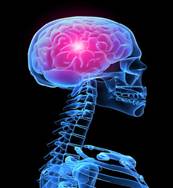
YOGA AND HEADACHE
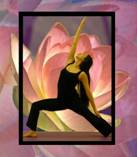
The various styles of yoga that have made it to the West all share a common core: positioning the body into a particular posture while focusing mind and breathe. This art of positioning the body has been passed on for thousands of years, and encompasses one of the oldest cultural traditions known to exist. To practice yoga then is also to join with the ancient sages, drawing human history up into yourself and connecting with the past.
YOGA POSES FOR HEADACHE
Downward Facing Dog Pose
Push butt up toward ceiling...fiercely. Push hands and heels of feet into floor and let head hang downward. Pull belly button up into spine. And breathe deeply. Avoid pinching shoulders. Push shoulders away from ears.
Cobra Pose
Start in a crawl position kneeling on the floor. Rest hands on floor in vertical alignment with shoulders. Sit butt back into heels of feet... inhale deeply. Now exhale and push head and torso forward into cobra. Do not push up with arms. Use chest and middle back muscles. The cobra is a backbend careful not to push in on lower back.
Reclining Pose
Gently roll torso back to floor... close eyes and breathe deeply. Avoid exercise if headache is acute or severe. Practice eye movements. Close eyes tightly...open widely. Roll eyes up and down and to the right and left. Circle eyes clock-wise and counter clock-wise. Palm eyes and forehead. Rub heels of palms together until warm, then place gently over eyes and feel the tension melt away as you visualize your happiest moments.
Bridge Pose
The Bridge Pose is also known as Setu Bandhasana which means construction of a bridge. It came from the words "setu" meaning bridge, "bandha" meaning lock, and "asana" meaning posture. Setu Bandhasana is effective in promoting relaxation and reducing stress. The legs and the hips do most of the work which helps in rejuvenating tired feet.
Cat Yoga Pose
The Cat Yoga Pose teaches you to initiate movement from your center and to coordinate your movement and breath. These are two of the most important themes in Yoga practice. Keep in mind that the Cat Pose may not be advisable if you have any chronic or recent back pain or injury.
Relaxation Yoga Pose
The first step in Yoga practice is to learn how to relax your body and mind properly. Learn how to do the corpse pose and other relaxation techniques. Know more about the art of physical, mental, and spiritual relaxation in this section.
Corpse Yoga Pose
The Corpse Yoga Pose is considered as a classic relaxation Yoga Pose and is practiced before or in between Asanas as well as a Final Relaxation. While it looks deceptively simple, it is actually difficult to perform.
Supported Cobbler's Pose
Sit, and place the soles of your feet together. Loop a strap around your sacrum and under your feet (run it between your legs), and lie back over a bolster with a blanket under your head. Place blocks or pillows under your thighs to relieve tension in the groin area.
YOGA ASANAS FOR HEADACHE
PASCHIMOTTANASANA
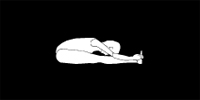
Paschimottanasana, the seated forward bend, is the fifth of the 12 basic postures of hatha yoga. There are many benefits of this posture; the main and most obvious one is to provide a complete stretch of the entire backside of the body from the back of the head through the heels. Immediately following this is the counter stretch, the inclined plane.
Steps
• Paschimottanasana begins by coming up to a seated position.
• Sit up straight with your legs together, stretched out in front of you. Point both feet straight up towards the ceiling.
• Be sure you are sitting straight up on the sitbones with your spine straight.
• Many people benefit at this point by removing the flesh from underneath the sitbones so as to help remove curvature in the spine.
• Inhale, and stretch your arms up over your head. Following the direction of your hands, at the same time lengthen the entire spine upwards.
SHASHANKASANA
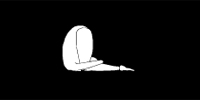
Relieving tension within the upper back and neck, this yoga pose also massages the digestive organs and stimulates the energies of the manipura and Svadhishthana Chakra.Shashankasana is a relaxing and rejuvenating pose, and therefore can be used when you are extremely weary or tired. After a hard day's work, it is often useful to wind down with this pose. It can also be used immediately after you wake up and get ready, as it gives you the energy to flow through another day. If you are able to relax in the morning with Shashankasana, you will glide through the day harmoniously.
Steps
• Sit in the Vajrasana position and hold your ankles with hands of the same side.
• Bend forward while exhaling and let the forehead touch the ground.
• Hold yourself in this position as long as you feel comfortable and come back to Vajrasana position.
• Do this at least 10 to 15 times to have maximum benefit.
PAVANMUKTASANA
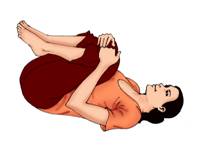
Pavan Muktasana strengthens the abdominal muscles and liver, spleen, pancreas and stomach. It eases excess gas from the abdomen. Persons suffering from constipation must do this after drinking lukewarm water for proper evacuation of bowels in the morning. Pavan Muktasana is the best asana to expel gas by compression of the abdomen.
Steps
• Keep your hands by the side of your body in a supine position. While inhaling, raise both your legs to 90 and bend them at the knees.
• Make a finger-lock with both your hands around them, a little below the knees. While exhaling, bring your thighs close to the chest by contracting the abdominal muscles. Maintain this posture for a few seconds.
• Then return to the original posture in the reverse order as Ardha Pavan Muktasana. Repeat the asana three to four times.
HALASANA
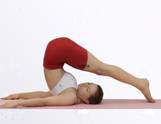
Steps
• Lie flat on your back.
• Raise the legs slowly and touch the ground with the toes above the ground.
• Keep the palms flat on the ground.
• Do this asana for 1to 2 minutes.
SARVANGASANA
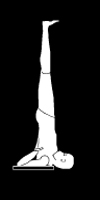
The Shoulder Stand stimulates and rejuvenates your entire body. In this exercise, you build up both power and a new structure in your back and you relax tension in well-known stress areas like the neck and the lower back. The muscles of your lower back get stronger, the chest and shoulders can move more freely and the back gets straighter.
Steps
• Lie flat on your back. Inhale deeply while raising your legs and spine until the toes point to the ceiling.
• The body rests on the shoulders and the back of the neck. The body is supported by the hands, which are placed on the center of the spine between the waist and the shoulder blades. Keep your spine and legs straight.
• Breathe slowly and deeply with the abdomen and concentrate on the thyroid gland. On a male, the thyroid gland is located behind the adams apple. For women, it is located in the same area which is a few inches above the sternal notch (hollow of the neck where the neck joins the rest of the body.) or approximately half way up the neck from the sternal notch. Stay in this position for about two minutes.
• To come out of this posture, just bend your knees, curve your back and slowly return to lying on the floor while exhaling. First bend your knees, put the palms on the floor, then curving the spine, gradually unfold it the way one unrolls a carpet. When your entire back touches the floor, straighten the knees, take a deep breath and slowly lower your legs to the ground while breathing out.
• If you wish, you may go straight into the next posture (the 'reverse posture') instead of lying down.
MATSYASANA
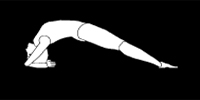
Matsya means fish. Unlike other asanas which are named after the resemblance of the body to a particular creature during the final position of the asana, the body does not resemble a fish during this asana. The asana is suggestive of the quality of floating like a fish - a state that's induced by assuming this posture. One would be able to float on water while in this asana. The term matsyasana conveys that while in water, one would be as comfortable as a fish if he / she are in this asana.
Steps
• Sit in Padmasana.
• Slowly take the help of your elbows to lie down on your back.
• Slowly lie on your back completely.
• Now with the help of elbows or palms bend your head backward and place middle of the head on the ground.
• Catch hold of the toes with your index fingers and place the elbows on the ground.
• While returning to original position, release the toes and taking the help of your hands straighten your head.
• Now taking the help of elbow sit in padmasana
ASTROLOGY
Yoga is a Sanskrit term which means 'to unite'. What is being referred as the 'Yoga' in English, is more commonly known as 'Asana' in Sanskrit, which means different physical postures and poses. It is seen that people of a particular sun sign find it beneficial when they practice certain yoga asanas.According to astrological reports for yoga asanas the above mentioned asanas are said to be effective for those who come under the following zodiac sign.
• ARIES
• GEMINI
• AQUARIUS